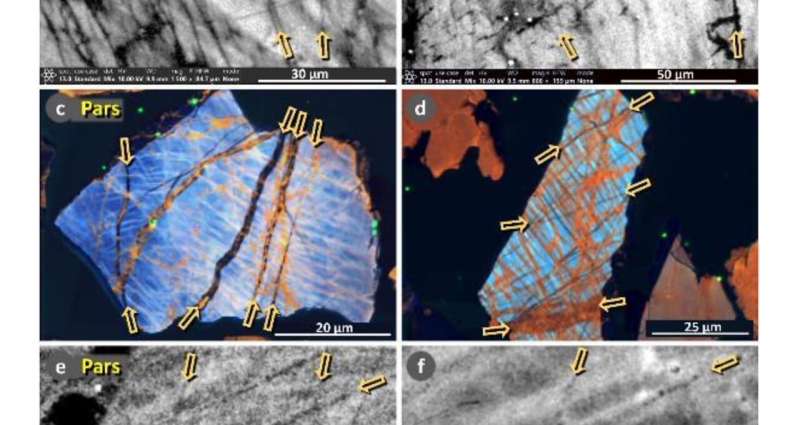
Shocked quartz grains, with cracks filled with molten glass. Credit: UC Santa Barbara
Researchers continue to explore the Younger Dryas impact hypothesis. This theory suggests that a fragmented comet crashed into Earth’s atmosphere 12,800 years ago, causing widespread climate change that, among other things, led to a sharp reversal in Earth’s warming trend and an anomalous quasi-glacial period called the Younger Dryas.
University of California, Santa Barbara, emeritus professor James Kennett and colleagues report the presence of materials associated with the cosmic explosion at several distinct sites in the eastern United States (New Jersey, Maryland, and South Carolina), materials indicative of the force and temperature involved in such an event, including platinum, microspherules, molten glass, and shock-fractured quartz. The study is published in the journal Airbursts and Craters.
“What we found was that the pressures and temperatures were not characteristic of major cratering impacts, but were consistent with so-called “touchdown” airbursts that do not form craters. not a lot of craters,” Kennett said.
The Earth is bombarded every day by tons of celestial debris, in the form of tiny dust particles. At the other end of the scale are extremely rare and cataclysmic impacts like the Chicxulub impact that caused the extinction of dinosaurs and other species 65 million years ago. Its 150-kilometer-wide impact crater is located in Mexico’s Yucatan Peninsula.
In between are impacts that do not leave craters on the Earth’s surface but are nonetheless destructive. The shock wave from the Tunguska event of 1908 destroyed 2,150 square kilometers of forest, when the asteroid approximately 40 meters in diameter collided with the atmosphere nearly 10 kilometers above the Siberian taiga.
The comet responsible for the Younger Dryas cooling event is estimated to have been 100 kilometers wide, much larger than the Tunguska object, and to have been fragmented into thousands of pieces. The sediment layer associated with the explosion extends across much of the Northern Hemisphere, but can also be found in locations south of the equator. This layer contains unusually high levels of rare materials associated with cosmic impacts, such as iridium and platinum, as well as materials formed under high pressure and temperature, such as magnetic microspherules (cooled metal droplets), molten glass, and nanodiamonds.
Shocked quartz and amorphous silica
Of particular interest to researchers is the presence of shocked quartz, indicated by a pattern of lines called lamellae that show stress high enough to distort the crystal structure of quartz, a very hard material. This “crème de la crème” of cosmic impact evidence is present in impact craters, but linking shocked quartz to cosmic airbursts has proven more difficult.
“In the extreme form, like when an asteroid hits the Earth’s surface, all the fractures are very parallel,” Kennett explained. In the realm of cosmic airbursts, there are different variables at play. “When you think about it, the pressures and temperatures that produce these fractures vary depending on the density, the angle of entry, the altitude of the impact, and the size of the impactor.
“What we found – and this is what is characteristic of the impact layer, called the Younger Dryas boundary – is that although we occasionally see in the quartz grains examples of traditional ‘shocked’ quartz “With parallel fractures, we mostly see grains that are not parallel,” he said. These fractures appear as an irregular, web-like pattern of sinuous lines and surface and subsurface cracks, contrasting with the parallel, planar deformations of the impact-associated shocked quartz found in the craters. These subparallel and subplanar deformations are largely due to the relatively lower pressures caused by explosions that occur above ground, the researchers say, as opposed to impacts that contact Earth.
What these sediments have in common with shocked quartz from crater sites is the presence of amorphous silica—molten glass—in these fractures. And that, the researchers say, is evidence of the combination of pressure and high temperatures (over 2,000 degrees Celsius) that could have come from a low-altitude bolide airburst. Similar fractured quartz grains and molten glass have been found in more recent samples from surface explosions, such as at the Trinity atomic bomb test site in New Mexico. The roughly 20-kiloton bomb exploded atop a 100-foot (30.5-meter) tower.
These low-pressure shocked quartz grains join a growing suite of impact indicators that together argue for a fragmented comet that not only caused widespread fires, but also abrupt climate change that led to the extinction of 35 genera of megafauna in North America, such as mammoths and giant sloths, and led to the collapse of a thriving human culture called Clovis, according to the researchers.
“There are a range of different shocked quartzes, so we need to establish a well-documented case for their importance to the interpretation of cosmic impacts, even if they don’t reflect a traditional major cratering event,” Kennett said. “These flakes come from very low-altitude airbursts, almost certainly associated with a cometary impact.”
More information:
Christopher R. Moore et al., Platinum, shock-fractured quartz, microspherules, and molten glass widely distributed in the eastern United States during the Early Young Dryas (12.8 ka), Airbursts and Crater Impacts (2024). DOI: 10.14293/ACI.2024.0003
Provided by University of California – Santa Barbara
Quote:New study reveals evidence of comet airbursts dating back 12,800 years (2024, June 26) retrieved June 27, 2024 from https://phys.org/news/2024-06-reveals-comet-airburst-evidence-years.html
This document is subject to copyright. Apart from any fair dealing for the purpose of private study or research, no part may be reproduced without written permission. The content is provided for informational purposes only.